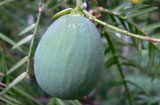Florida Torreya
The Florida torreya (Torreya taxifolia) is an endangered conifer that is found the Apalachicola River region of the Florida panhandle and southern Georgia. There are five species of Torreya across North America and Asia, but T. taxifolia is the rarest conifer in North America and one of the most endangered in the world.
Description and Habitat
This evergreen tree historically grew to sixty feet and still sometimes reaches that height in cultivation. The slow growing torreya forms a conical shape with a twenty foot canopy spread. Its whorled branches have short, dark needle-like leaves. The leaves and female cones have a pungent odor, which gives it the name “stinking cedar.”
Florida torreyas are found in the wild in the Apalachicola drainage of Gadsden and Liberty counties and south Decatur County in Georgia. There is also a group growing west of the Apalachicola in Jackson County.
Decline
Prior to WWII, the Florida torreya was a common tree in its habitat. A decline in abundance was first noticed in the late 1930s; by 1960, no adult trees could be found. The decline has continued due to disease, forest changes, heavy browsing by deer, and an end of seed reproduction in the wild. Florida torreyas have decreased approximately ninety-nine percent since 1914, and recent estimates since 2000 put the torreya population around four to six hundred.
Disease in the form of leaf spots and stem cankers has been the main cause of the decline. Research determined that the symptoms were caused by two different fungal species: Fusarium lateritium (leaf spots) and an unknown Fusarium species (canker). Researchers have also looked into environmental changes, but diseases remains the single important factor in why the Florida torreya has seen such dramatic losses.
Current Status
The remaining native Florida torreyas number in the hundreds, and most are only stump sprouts about one to three feet tall. Much like the American chestnut and the chestnut blight, the torreya resprouts from its stump once disease has killed its stem. Disease keeps these trees from reaching maturity, and seed reproduction has not been observed in decades.
A collaborative effort between government, horticultural, and academic institutions and citizen volunteers is focusing on finding and mapping remaining trees on protected and private lands to understand the distribution and survival patterns of the torreyas. So far, two hundred and twenty-five trees have been surveyed; they have an average height of less than one meter and canker is present on ninety percent.
Current research and conservation includes using cuttings to cultivate torreyas that will produce seed and mass production of cloned torreyas. Without a management strategy for the canker disease, however, re-introduction of cultivated individuals into the torreya native range will make no difference. Some citizen groups have worked on introducing torreyas on alternative sites in an effort to conserve them. There has been no research on the effectiveness of this approach, and it is not without its own risks, such as movement of the disease.
For now, the survival of the Florida torreya depends upon the increased understanding of the canker-causing Fusarium and developing a management plan for wild populations that includes re-population with cultivated seed and trees.
Adapted and Excerpted From:
Jason Smith and Aaron Trulock, The Decline of Florida Torreya: An Endemic Conifer on the Edge of Extinction (FOR276), School of Forest Resources and Conservation (11/2010).

Related Sites & Articles
- UF/IFAS Publications
- Florida Torreya
- UF/IFAS Sites
- UF/IFAS expert helps solve 80-year mystery, as team identifies fungus killing Torreya trees
- Other Sites & Publications
- Whitewater Floodplain Forests
- US Forest Service—Torreya taxifolia

